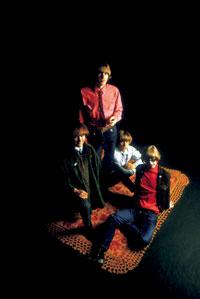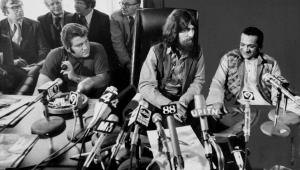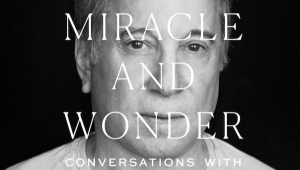The Byrds Reconsidered: The 1996 Legacy CD Reissues

The Musicians
Roger McGuinn. McGuinn co-founded the group with Gene Clark and was its nominal leader. If you disassemble the complex tapestry of the Byrds' sound into its molecular underpinnings, McGuinn's distinctive voice and unique twelve-string Rickenbacker guitar are the nucleus. Lead guitarist McGuinn's unique style simultaneously employs a flat pick and fingerpicking patterns, drawing
more from five-string banjo rolls than typical guitar scales. When this unusual picking pattern is done on an electric twelve-string Rickenbacker guitar, the resulting sound is a brilliant cascade of harmonic intervals and gleaming overtones. McGuinn also sang lead on many of the group's songs, including all of their Dylan interpretations.
Since the Byrds, McGuinn has primarily worked as a solo artist, returning in recent years to his folk roots by playing small clubs accompanying himself on guitar. His stage show consists of an autobiographical excursion through his musical career. His most recent release, Live from Mars (Hollywood Records) is a compilation culled from his stage shows over the past two years plus two bonus studio tracks recorded with members of the Jayhawks. His previous album, Back From Rio (Arista AR-8648), was released in January, 1991. The vinyl version (AL-4648), if you can locate a copy, sounds much better than the compact disk.
Note to guitarists: McGuinn has an instructional guitar video available on Homespun Tapes ( "The 12-String Guitar of Roger McGuinn", Homespun VD-GUI-GT01). It is worthwhile, but it spends too much time going over how to change strings and adjust the truss rod on a Rickenbacker 12-string, and not enough time dissecting his Byrds guitar work (which is surely the reason most people would purchase the tape).
For reasons known only to himself, McGuinn is vehemently opposed to doing any further work with the Byrds, much to the chagrin of David Crosby and Chris Hillman (see my interviews in this issue with McGuinn, Crosby and Hillman for more on this). McGuinn avows that he wants to be free of the yoke of the Byrds, yet, paradoxically, he is the one who earns his living going around playing "Mr. Tambourine Man" and "Turn! Turn! Turn!" for the thousandth time.
David Crosby.
Crosby's role in the Byrds was rhythm guitarist and high harmony singer. His chunky rhythm work perfectly complimented McGuinn's elaborate baroque arpeggios. One of the benefits afforded by the sonic excellence of the reissue CDs is that Crosby's rhythm guitar work can be more easily detected and more greatly appreciated. Although not as prominent or attention-getting as McGuinn's signature twelve-string sound, Crosby's rhythm playing was a significant, integral (and neglected) element in the Byrds' musical mosaic.
Crosby was responsible for the Byrds' wonderful vocal harmonies. He is one of the most creative harmony singers in rock in terms of experimenting with unusual harmonic intervals. Not surprisingly, his musical background is permeated with jazz influences, which can be heard in the highly unorthodox harmonies he creates. His crystalline high voice is absolutely gorgeous on these four discs. His work with the Byrds comprises some of the finest vocal harmony work in the history of rock.
Of all the Byrds, Crosby achieved the greatest level of fame and success through his post-Byrds work in Crosby, Stills, and Nash. For something lesser known, try his striking inaugural solo album If I Could Only Remember My Name (Atlantic SD 7023 or, even better, the British pressing, Atlantic K 40320). Engineered by Steven Barncard, this album has earned accolades for its sonic (as well as musical) merit.
At the present time, Crosby is touring with CSN. As indicated in our interview, he feels that he has recently written some of the best material of his career. These new songs are scheduled for an upcoming Crosby, Stills and Nash album.
Chris Hillman.
Hillman's musical background was in bluegrass and countr music. Although he was the bassist in the original Byrds, he had never touched the instrument prior to joining the group. He was a virtuoso mandolin player who had his own bluegrass group called the Hillmen. Hillman's evolution as a bassist is vividly evident when you play these discs through in order. On the older material, he is the quintessential basic bassist. As his skill on the instrument progressed, he began weaving some omplex magical counterpoint on the bass, unlike anything else done at the time.
Initially, Hillman did not sing in the Byrds. However, after Gene Clark left the group, the instant bass player became an instant vocalist as well. He also became one of the group's best songwriters making outstanding contributions to both Younger Than Yesterday and The Notorious Byrd Brothers .
Along with the late Gram Parsons, Hillman is considered the father of progressive country/country-rock music, which has reached unimagined levels of popularity in the last few years. After leaving the Byrds, Hillman founded the Flying Burrito Brothers along with Parsons. Later he played in Manassas with Stephen Stills, was in the SHF Band with Richie Furay and J.D. Souther, and did several solo albums. He then founded and fronted the Desert Rose Band, one of the finest progressive country ensembles. Some of Hillman's best compositions grace the DRB albums, ably abetted by Herb Perdersen's sublime vocal harmonies and John Jorgenson's extraordinary guitar work.
Hillman has maintained a relatively low profile since disbanding the Desert Rose Band. He released a duet album with Herb Perdersen entitled Bakersfield Bound (Sugar Hill SHCD-3850) earlier this year. At present he is working on a solo album.
Gene Clark.
During his regrettably short tenure with the Byrds, Clark was the bands primary songwriter. Certainly the most prolific writer in the group, and arguably the most consistently excellent, he crafted many fine songs over the years which amply display his melodic and lyrical talent. Vocally, Clark was the most expressive singer in the Byrds. Although a competent rhythm guitarist, Clark's instrumental role in the Byrds was that of tambourine man.
Since Clark left the Byrds in 1966, shortly after the recording of "Eight Miles High." he is heard only on the first two discs in this series (Mr. Tambourine Man and Turn! Turn! Turn! ). The reason given for his departure was ironically fear of flying. Clark also had a difficult time coping with the internal and external stresses of being in a preeminent rock band. As time went on, Clark did not fare well competing with some of the stronger personalities in the Byrds. A number of his songs were left off albums, replaced by weaker fare written by other members of the group.
Clark's post-Byrds work was primarily as a solo artist. Qualitatively, much of it was uneven. One of his strongest efforts was a superb duet album with Carla Olson of the Textones (So Rebellious a Lover, Rhino RNLP 70832). Regrettably, Gene Clark passed away on May 24, 1991, shortly after The Byrds were inducted into the Rock and Roll Hall of Fame. The induction ceremony marked the last time that the original five Byrds would meet as a group.
Michael Clarke.
Clarke was the Byrds' drummer. Legend has it that David Crosby "discovered" Clarke playing congas at Big Sur, and that Clarke was
invited to join the Byrds because he looked like the quintessential rock and roller. Like Hillman, he had never played his chosen instrument prior to the Byrds. Unlike Hillman he had no previous musical experience of any kind and his drumming was the weakest link in the Byrds.
Though he never sang or wrote any songs during his tenure with The Byrds- he didn't even play drums on many Byrds records- much to the consternation of the others, Clarke toured extensively with a bogus group calling itself "The Byrds." He had the dubious distinction of being the catalyst for some truly acrimonious litigation between the Byrds in the early 1990s. As Chris Hillman put it, it would be like Ringo Starr touring with three unknowns and billing the group as The Beatles.
Although Clarke was, at best, an inconsistent drummer, he did have a
distinctive style of playing. His untrained, unorthodox drumming technique was an integral ingredient in the Byrds' sound. In the studio, on occasion, he was capable of some fine work (e.g., "Turn! Turn! Turn!," "Eight Miles High"). Much of his recorded drum work, though, was pedestrian and unimaginative (most of the Younger Than Yesterday album, for example). On stage, Clarke's inability to keep a steady beat really hurt the overall tightness of the group -as McGuinn, Crosby and Hillman all attested to when I spoke with them.
After his departure from the Byrds, Clarke played with Hillman's Flying Burrito Brothers until the demise of that group. Ironically, he then achieved greater commercial success than any other Byrd save Crosby, as Firefall's drummer.
Michael Clarke passed away in December, 1995, leaving only Roger McGuinn, David Crosby and Chris Hillman as surviving members of the original Byrds (and in Crosby's well publicized case, that survival has been tenuous at best).
The Discs
During their brief three-year existence, the original Byrds released five [FOOTNOTE 1] albums plus a compilation,The Byrds' Greatest Hits . Each in its own way was a masterpiece. Remarkably, the first four were all recorded in a brief two year period-1965 and 1966. Given the protracted gestation of today's records, such a fusion of quality and quantity in just two years seems almost inconceivable. To further feather the Byrds' nest, add to this body of work the high-caliber bonus tracks included in these reissues that were not on the original albums. An extraordinary musical legacy.
One problem confronting reissue collection producers is how best to balance the idiosyncratic needs of diehard collectors with the musical preferences of the general buyer. Ideally, previously unreleased tracks should stand on their own musical merit, thus satisfying both groups. In reality, the aesthetic criteria that excluded the unreleased material in the first place often applies equally well today. Cram too many substandard, curiosity tracks on a reissue release, and the underlying musical quality of the disc is compromised.
With a few exceptions, the most egregious of which is tormenting the listener with three versions of Crosby's abominable "Mind Gardens" on the Younger Than Yesterday disc, Legacy has done an excellent job in selecting the bonus tracks.
There is one final comment I want to make before discussing the individual discs. It has to do with the "sound" quality rating given to each disc. Please be advised that these are not audiophile/natural sound recordings. They are very good mid-1960s pop music recordings, meticulously transferred to compact disc. Given the nature of the source material, the audio quality of these discs is exceptional.
Mr. Tambourine Man
Produced by Terry Melcher
Engineered by Ray Gerhardt
Reissue produced by Bob Irwin
Reissue mixed and mastered by Vic Anesini Columbia/Legacy CK 64845
MUSIC: 11.
SOUND: 10.
Released on June 21, 1965, Mr. Tambourine Man was the Byrds' stunningly auspicious debut album. From their disparate musical backgrounds, the Byrds conjured up a startlingly fresh and unique sound. There was nothing remotely like it at the time. During their interviews with me, McGuinn, Crosby and Hillman all averred that this singular potpourri was a direct result of the group's inexperience as a rock band. They were the antithesis of the typical garage band. They had never even played electric instruments nor bass nor drums before. Their heritage was folk, jazz, bluegrass, and choral music. They honed their sound- sometimes very painfully-
under the relentless eye of veteran producer Jim Dickson and the exacting "ear" of the multi-track tape deck at World Pacific Studios.
The Byrds are best known (and most imitated) for the distinctive jangly folk-rock sound exemplified by the Mr. Tambourine Man and Turn! Turn! Turn! albums. Although this style is widespread today, remember that in 1965 folk and rock music were completely separate, dissimilar musical genres. If you listen to the folk and rock music of the early 60's, you will find virtually no points of intersection. What the Byrds did with Mr. Tambourine Man was to seamlessly meld the melodic beauty and lyrical sophistication of folk music with the vibrancy, beat and energy of rock.
Above all, the Byrds-especially McGuinn and Crosby at the time-were master song arrangers. To hear just how much of the stellar beauty of the folk-rock songs on Mr. Tambourine Man is due to the Byrds' arrangements and execution, listen to the original folk versions of the material (e.g., Dylan's 3/4 demo version of "Mr. Tambourine Man" or, later, Pete Seeger's rendition of "Turn! Turn! Turn!"). The Byrds' presentations of these songs are light years ahead of the originals.
Beneath the masterful arrangements, there are several key musical elements that stand out on the Mr. Tambourine Man album. First are Roger McGuinn's chiming electric twelve-string guitar and distinctively effective vocals. Next are Gene Clark's wonderful songwriting and singing. Finally, David Crosby's high harmony work is glorious, adding immeasurably to the material on the album.
The strength of the Mr. Tambourine Man disc is underlined by how little it is improved by the bonus tracks. The core material is truly first rate. On most of the other Byrds' reissues, the original album would have been appreciably improved by the substitution of some of the bonus tracks for some of the original tracks. About the only change I would have made on Mr. Tambourine Man would be to include Gene Clark's lovely "She Has a Way" in place of "Spanish Harlem Incident," the harder-rocking "It's No Use," or the Bo Diddley-like Jackie DeShannon opus "Don't Doubt Yourself Babe."
Mr. Tambourine Man is one of the finest debut efforts in rock music. Remember that at the time, most popular music albums consisted of a hit single coupled with a bunch of mediocre filler, Every song on Mr.Tambourine Man stands artistically on its own.
Even today, more than thirty years later, it sounds substantive and musically meritorious. It is a wonderful blend of then-novel folk-rock, haunting ballads, and uptempo rock, all impeccably executed by an amazingly young and inexperienced group. If you want the one album In this series that utterly defines the classic sound of the Byrds, this is it.
Turn! Turn! Turn!
Produced by Terry Melcher
Engineered by Ray Gerhardt
Reissue produced by Bob Irwin
Reissue mixed and mastered by Vic Anesini
Columbia/Legacy CK 64846
MUSIC: 10
SOUND: 10
Released on December 6, 1965 (I remember getting a copy for Christmas), Turn! Turn! Turn! was the Byrds' second and final folk-rock masterpiece. The front of the album jacket-a beautiful portrait in various shades of blue-showed the group at their most pensive. The back jacket consisted of truly hip liner notes from the pen of Derek Taylor, the Press and Public Relations Officer for both the Byrds and the Beatles. When perused in 1996, Taylor's notes are a like a fascinating morsel from a 1960's time capsule. They capture the Zeitgeist of that era with sparkling vitality.
Ably anchored by its monumental title track, on Turn! Turn! Turn! the Byrds did not fall victim to the sophomore jinx that afflicts many precocious bands who prove unable to sustain their initial level of musical creativity. That said, the second album does not quite equal the benchmark the group established with Mr. Tambourine Man. The problem does not lie in the Byrds' vocal or instrumental prowess. If anything, they are even better. The core musical elements present on Mr. Tambourine Man also shine brightly on Turn! Turn! Turn! And both Michael Clarke and especially Chris Hillman had really matured on their respective instruments.
The problem is, much of the material selected by producer Terry Melcher and the Byrds simply isn't as good. In particular, the latter portion of the disc, starting with the plodding "Satisfied Mind", isn't quite up to the sterling standard established on Mr. Tambourine Man., though many of the songs on Turn! Turn! Turn! are- including the title song, "It Won't Be Wrong," "Set You Free This Time," and "The World Turns All Around Her."
Reportedly the Turn! Turn! Turn! recording sessions were less than blissfully harmonious. The Byrds were superstars at this point, and egos and personalities clashed. One sore point was the distribution of income from songwriting royalties. Gene Clark wrote most of the original material on Mr. Tambourine Man, and accordingly reaped more financial reward from its success. Some of the stronger willed members of the group wanted to flex their compositional muscle on Turn! Turn! Turn! . This led to the exclusion of better songs for weaker efforts, to the detriment of the album.
In fact, it is possible to fashion a new, much improved version of Turn! Turn! Turn! by removing some of the torpid original songs and replacing them with superior material culled from the bonus tracks. Out would be "Lay Down Your Weary Tune" (and what a droning, weary tune it is, without doubt the Byrds' worst Dylan effort). Also out would be the aforementioned "Satisfied Mind." Even though this track could be called pioneering in that it is the first fusion of country-western with rock, it is a real snooze of a song.
In would be Gene Clark's superb "She Don't Care About Time" (the B-side of the "Turn! Turn! Turn!" single, egregiously omitted from the album). Also in, replacing Dylan with Dylan, would be "It's All Over Now, Baby Blue," which has its faults, but at least it doesn't induce involuntary R.E.M. in the listener.
The final change I would make would be to substitute the bonus track version of "The Times They Are A-Changin'" for the standard incarnation. The bonus version is really much better, although a bit manic in pace. With these changes, Turn! Turn! Turn! Is transformed from an excellent record to a great one.
The inclusion of the seven bonus tracks really strengthens the Legacy reissue of Turn! Turn! Turn!. So much so, in fact, that it would be worth purchasing solely for that reason. Of course you also get the factoid-filled booklet, the vastly improved sound, and the resplendent beauty of classic Byrdsound (as the teen mags of the day called it). The latter became something to be treasured, as the group would soon abandon their established turf of electrified folk music and chiming twelve-strings. Turn! Turn! Turn! is replete with this captivating sound. If you relish the timeless beauty of the Byrds' original signature sound, you must have the bookend Legacy reissues of both Mr. Tambourine Man and Turn! Turn! Turn!.
Fifth Dimension
Produced by Allen Stanton
Engineered by Ray Gerhardt
Reissue produced by Bob Irwin
Reissue mixed and mastered by Vic Anesini.
Columbia/Legacy CK 64847
MUSIC: 9
SOUND: 10
Throughout their too-brief lifespan, the original Byrds were consistent innovators, insistently expanding the artistic envelope of rock music. It comes as no surprise, then, that they readily jettisoned the patented folk-rock sound they had originated when it became overpopulated with inferior imitators. When the Byrds were at the apex of their commercial success, they radically changed musical direction, turning away from the identifiable sound upon which they had built their popularity.
Before the Turn! Turn! Turn! album had even hit the store shelves, the Byrds were holed up in a recording studio, working on the phenomenal, wildly creative, commercially venturesome "Eight Miles High." This song is now regarded as one of the greatest rock singles ever, but at the time it was a sure path to obscurity. How could a lengthy three plus minute, free-form excursion into dissonant jazz and celestial lyrics scale the top-of-the-pops early in 1966? There was no "acid-rock," no counter-culture, no underground FM radio.
The Fifth Dimension album was one of many forays the Byrds made into unchartered musical territory. In many ways it is their most experimental album, in the truest sense of the term. It is also their most qualitatively erratic, veering from brilliant ("Eight Miles High") to repetitious and mundane ("Captain Soul," "The Lear Jet Song," both of which show the transient longevity of novelty songs).
In addition to the drastic stylistic change, the Byrds had to contend with the loss of their primary songwriter, Gene Clark, who left shortly after "Eight Miles High" was recorded. In addition, the group decided against doing any Bob Dylan songs on Fifth Dimension. No wonder Fifth Dimension is somewhat uneven.
Roger McGuinn and David Crosby stepped up their songwriting efforts, but the results were not enough to compensate for the loss of Clark and Dylan. However, what Fifth Dimension lacks in compositional cachet, it more than makes up for in sheer unbridled creativity and experimentation. And there are some nice links to the past in the beautifully understated renderings of "John Reilly" and "Wild Mountain Thyme," two traditional folk songs reworked by the Byrds. Although these tracks are technically "folk-rock" in that they are modernized folk songs, the style and arrangements
(including strings) are unlike the material on the group's first two albums.
Fifth Dimension proved to be a trendsetting, highly influential album. It was here that the Byrds initially dabbled in atonal jazz and Indian raga (listen to McGuinn's guitar breaks on the original version of "Why" or on Crosby's droning "What's Happening?"). In fact it was during the Fifth Dimension sessions that the Byrds first introduced the Beatles to the sitar and Indian music in general. We all know what happened next.
While heartily acknowledging the album's brilliance, it must also be said that Fifth Dimension has some noble misfires. Certain ideas that may have been conceptually intriguing, didn't survive the transition into tangible music very well.
From a purely quantitative standpoint, Fifth Dimension has more weak tracks than any other album by the original Byrds, although it contains many fine selections as well. As with Turn! Turn! Turn!, some of the bonus tracks on the reissue should have been selected for the original album. Why they were not, puzzles even the Byrds themselves. David Crosby attributes these errors in musical judgement to the addle-brained producers (his opinion) the Byrds were saddled with.
Fifth Dimension, then, can be materially improved by "re-producing" the album in 1996. Gone, with gusto are "Captain Soul" (the only Byrds instrumental, reportedly recorded at the insistence of Michael Clarke) and "The Lear Jet Song" (airplane fascination run amok).
In their place would be the strong Crosby-McGuinn tune "Why", the B-side of the "Eight Miles High" single, and a strong Crosby-McGuinn tune inexplicably left off the album, and the wonderfully energetic "I Know My Rider," some of which technically speaking, may have been recorded after the release of Fifth Dimension.
It doesn't require microanalysis of the recording logs to determine this. "I Know My Rider" features intricate, staggered three-part vocal harmonies with Chris Hillman's voice clearly audible in the mix. Hillman did very little vocal work on Fifth Dimension. What singing he did was primarily to double some of McGuinn's parts. At the time he was not indulging in the kind of vocal gymnastics that permeate "I Know My Rider." Fifth Dimension is primarily McGuinn and Crosby. As a result, the overall vocal mix is not as full bodied as it was on the group's first two albums.
As with Turn! Turn! Turn!, the bonus tracks on the reissue CD really augment Fifth Dimension. It is a fascinating glimpse of the Byrds at their most musically turbulent. Absolutely worth the price of admission.
Younger Than Yesterday
Produced by Gary Usher
Engineered by Bob May(and possibly Roy Halee)
Reissue produced by Bob Irwin
Reissue mixed and mastered by Vic Anesini
Columbia/Legacy CK 64848.
MUSIC: 11
SOUND:11
In every sense, Younger Than Yesterday is an utterly brilliant album,
arguably the Byrds' best. Musically, with one exception [FOOTNOTE 2], every song is sterling. Sonically, Younger Than Yesterday is significantly better than the earlier albums. When originally released in February, 1967, it was one of the first albums that was worth paying the extra dollar for the stereo version. Younger Than Yesterday and the subsequent Notorious Byrd Brothers are by far the most deftly mixed, best sounding Byrds albums. Both were produced by Gary Usher, whose work was praised by both McGuinn and Hillman in their interviews.
Younger Than Yesterday is a scrumptious smorgasbord of eclectic musical styles and groundbreaking innovation. Among the noteworthy musical elements are: Latin and South African ("So You Want to be a Rock and Roll Star"), country-western ("Time Between," "The Girl With No Name"), jazz ("Everybody's Been Burned"), Indian raga ("Why"), electronic synthesizer ("C.T.A.-102"), backwards tracking and phasing ("Thoughts and Words," "Mind Gardens"), folk music ("My Back Pages"), highly inventive chord structures, progressions, and instrumentation ("Renaissance Fair"), and straight melodic rock ("Have You Seen Her Face," which is built on a series of seventh chord backbeats).
Perhaps even more significant than this impressive list of musical "firsts" is the way the Byrds blended these diverse ingredients into their own distinctive musical style. Above all, these disparate, creative elements serve a musical purpose. They are not clumsily grafted on as afterthoughts, extant solely for "innovation's" sake.
One of the most amazing things about Younger Than Yesterday is that the entire album, from start to finish, was recorded in just eleven days! In today's recording world, it can take more than eleven days just to get the rhythm track for a single song finished. That the Byrds could produce such a superlative collection in less than two weeks is a potent tribute to their creativity and musicianship.
Without question, Younger Than Yesterday is Chris Hillman's finest moment with the Byrds. When he first joined the group, Hillman was a reticent background figure. In fact, the original contract between Columbia Records and the Byrds included only McGuinn, Crosby, and Gene Clark. Hillman and Michael Clarke were restricted to concert appearances, they were not to appear in the recording studio. From these humble beginnings, the young mandolin prodigy blossomed into a key member of the group.
Hillman sang some background vocals on Fifth Dimension after Gene Clark's departure. By the time Younger Than Yesterday was recorded, he had gained full parity with McGuinn and Crosby. Hillman, who had never written a song before, wrote four and co-wrote one of the eleven songs on Younger Than Yesterday. He stepped up and capably took the lead vocal on three of his compositions, added a third harmony part to "My Back Pages", and sang in unison with McGuinn on most of the other songs on the album.
Hillman's bass work on Younger Than Yesterday is superbly original, imaginative and intricate (in particular, listen to the complex creativity he displays on "Renaissance Fair" and "Everybody's Been Burned"). As Crosby noted years later in a Rolling Stone interview, "listen to his running jazz bass work, nobody else was doing anything like that at the time." Although Hillman is underappreciated as a bassist, it is surprising how often he is
positively cited (even today) in periodicals specializing in bass guitar.
In spite of its aesthetic excellence, Younger Than Yesterday was largely ignored by the record buying public, but certainly not by other musicians. By 1967, the Byrds were no longer megastars. Their last Top 10 single was 1965's "Turn! Turn! Turn!." Even though popular attention at the time was still focused on The Beatles, Younger Than Yesterday has garnered extensive critical praise over the years and is widely regarded as one of the most influential albums of its era.
As with the other Legacy reissues in this series, Younger Than Yesterday benefits from the inclusion of some excellent bonus tracks. However, the core album is so strong that I would make only one change in the original song lineup. Unhesitatingly gone is the self-indulgent ranting dissonance of Crosby's "Mind Gardens" (the only Byrds' song ever that belongs in an aversive conditioning experiment). Showing the other side of his nature is Crosby's superlative "Lady Friend," the best of the bonus tracks. However, to be fair, "Lady Friend" was recorded after Younger Than Yesterday was released, and as such really belongs on The Notorious Byrd Brothers [FOOTNOTE 3]. So, to maintain chronological authenticity, I would substitute Crosby's "It Happens Each Day" in place of the much-maligned "Mind Gardens." Ah, blissful relief.
Younger Than Yesterday merits a place in the very top tier of the Byrds' distinguished musical catalog. Add the greatly improved sound, intriguing annotation and photos, and the fine additional songs of the Legacy reissue, and an already great album is made even better.
FOOTNOTE 1: The fifth album was The Notorious Byrd Brothers. From the standpoint of completeness, it would have been nice if Legacy had reissued all five original Byrds recordings at the same time, rather than just the first four. Although there are links between Notorious Byrd Brothers and the subsequent Sweetheart of the Rodeo, Notorious ... really belongs with the four discs in this set.
FOOTNOTE 2: Curious to know which one is the clunker? Here is a clue: "Once upon a time, there was a garden ..... and kept it from the slings and arrows of outrageous fortune."
FOOTNOTE 3: In fact, many of the bonus songs on Younger Than Yesterday were actually recorded after the album was released. This are two possible explanations for this anomaly: 1) There are precious few outtakes from this album and/or, 2) the next Byrds' album The Notorious Byrd Brothers has an overabundance of unused tracks. To determine the real deal, I posed the question to project producer Bob Irwin. Irwin informed me that reason two was the primary reason for this inter-album time shift. Apparently there are numerous alternative tracks from the Notorious .... sessions. Something to look forward to when that CD is reissued.
- Log in or register to post comments
















































